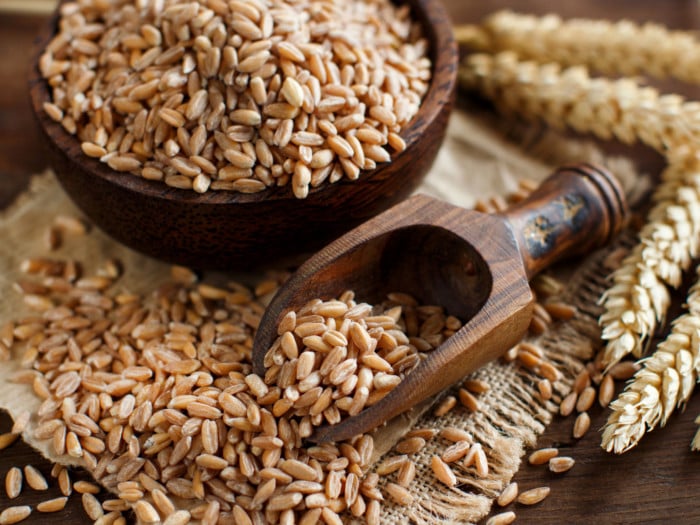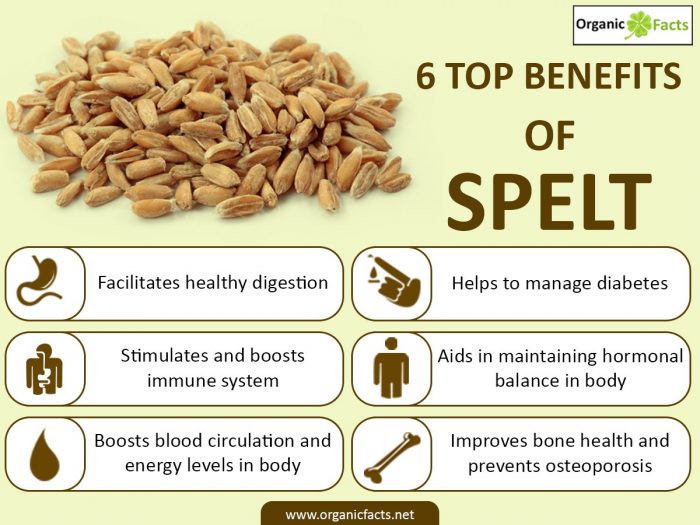The health benefits of spelt may include its ability to help regulate metabolism, aid in the creation of sex hormones, increase circulation, build strong bones, improve the immune system, boost the digestive function, and lower blood sugar and LDL cholesterol levels in the body.
What is Spelt?
Spelt is one of the oldest cultivated crops in human history and is believed to have first been used approximately 8,000 years ago. Spelt is a variety of grain or cereal that is closely related to wheat. In fact, spelt likely developed from hybridization of emmer wheat and wild goat-grass. It is closely related to normal “bread” wheat, but the popularity of bread wheat soon made spelt obsolete, which is why it is considered a “relic” crop. [1]
However, it is making a comeback as a health food, particularly in Spain, the United Kingdom, and other parts of Europe. It is actually packed with nutrients, vitamins, minerals, and essential organic compounds that other cereals and forms of wheat don’t contain, which might explain the renewed interest in spelt. The scientific name of this ancient food staple is Triticum spelta, but it is more commonly known as hulled wheat or dinkel wheat.
Spelt Flour
Spelt flour can be purchased at some supermarkets and most health food stores in England, the Netherlands, Germany, and in various parts of North America. The flour can be used to bake highly textured and nutrient-rich bread, as well as pasta and baked goods. In certain countries like Bavaria and Belgium, spelt is actually used to brew beer and has a unique, distinct flavor that many people enjoy. Obviously, as a minority product, spelt does have a slightly higher price tag, but it is worth the cost, not only for the health benefits but also for the versatility it offers in cooking. [2] [3]
Spelt flour is particularly preferred in making bread crusts or flatbread pizzas, as the wheat will harden without becoming tough or leathery like other varieties of wheat. Now, let’s take a look at what makes spelt such a healthy option in our diet.

Spelt flour is an alternative to standard flours that offers its own unique benefits for your baked goods and flour needs Photo Credit: Shutterstock
Serving Size : Nutrient Value Water [g] 11.02 Energy 338 Energy [kJ] 1414 Protein [g] 14.57 Total lipid (fat) [g] 2.43 Ash [g] 1.78 Carbohydrate, by difference [g] 70.19 Fiber, total dietary [g] 10.7 Sugars, total including NLEA [g] 6.82 Sucrose [g] 0.59 Glucose (dextrose) [g] 0.84 Fructose [g] 0.24 Maltose [g] 5.15 Starch [g] 53.92 Calcium, Ca [mg] 27 Iron, Fe [mg] 4.44 Magnesium, Mg [mg] 136 Phosphorus, P [mg] 401 Potassium, K [mg] 388 Sodium, Na [mg] 8 Zinc, Zn [mg] 3.28 Copper, Cu [mg] 0.51 Manganese, Mn [mg] 2.98 Selenium, Se [µg] 11.7 Thiamin [mg] 0.36 Riboflavin [mg] 0.11 Niacin [mg] 6.84 Pantothenic acid [mg] 1.07 Vitamin B-6 [mg] 0.23 Folate, total [µg] 45 Folate, food [µg] 45 Folate, DFE [µg] 45 Carotene, beta [µg] 5 Vitamin A, IU [IU] 10 Lutein + zeaxanthin [µg] 169 Vitamin E (alpha-tocopherol) [mg] 0.79 Tocopherol, beta [mg] 0.25 Tocopherol, gamma [mg] 1.71 Tocotrienol, alpha [mg] 0.35 Vitamin K (phylloquinone) [µg] 3.6 Fatty acids, total saturated [g] 0.41 16:0 [g] 0.37 18:0 [g] 0.02 20:0 [g] 0 22:0 [g] 0.01 Fatty acids, total monounsaturated [g] 0.45 16:1 [g] 0 18:1 [g] 0.42 20:1 [g] 0.02 Fatty acids, total polyunsaturated [g] 1.26 18:2 [g] 1.19 18:3 [g] 0.07 18:3 n-3 c,c,c (ALA) [g] 0.07 Tryptophan [g] 0.13 Threonine [g] 0.44 Isoleucine [g] 0.55 Leucine [g] 1.07 Lysine [g] 0.41 Methionine [g] 0.26 Cystine [g] 0.33 Phenylalanine [g] 0.74 Tyrosine [g] 0.38 Valine [g] 0.68 Arginine [g] 0.69 Histidine [g] 0.36 Alanine [g] 0.53 Aspartic acid [g] 0.76 Glutamic acid [g] 4.65 Glycine [g] 0.6 Proline [g] 1.63 Serine [g] 0.73 Sources include : USDA [4]
Spelt Nutrition Facts
Apart from being a very functional and versatile variety of wheat, spelt is also packed with nutrients that many other kinds of cereal do not contain. It is possibly high in carbohydrates, as you would expect, but is also known to be notably high in protein levels (21% of the daily recommended intake) and its levels of dietary fiber (30% in a single serving!) are known to be very impressive. On top of those important compounds, spelt may also contain significant levels of iron, manganese, magnesium, phosphorus, potassium, zinc, selenium, niacin, thiamin, vitamin B6, and folic acid. [5]
Health Benefits of Spelt
The amazing health benefits of this cereal are explained in detail below.
May Help Facilitate Digestion
The high content of fiber in spelt means that it may facilitate healthy digestion in a major way. Dietary fiber helps bulk up the stool and move food through the digestive tract, speeding up the absorption of nutrients and also possibly helping reduce conditions like constipation, bloating, cramping, excess gas, diarrhea, and more serious gastrointestinal issues like ulcers. Spelt has one of the highest dietary fiber contents of wheat varieties. [6]
May Control Cholesterol Levels
Dietary fiber has a second role in the body, which is known to help lower the levels of dangerous cholesterol in the body. Dietary fiber can interact with the cholesterol uptake processes and it also inhibits the absorption of cholesterol from food. In fact, it can specifically target LDL or bad cholesterol and eliminate it from the body to regulate a healthy balance of fatty acids in the body. [7]
May Improve Blood Circulation
The high levels of iron in spelt combine to possibly boost blood circulation. Iron can be essential for the creation of red blood cells. When RBC production is up, there is an increased blood flow throughout the body, which means additional oxygenation to organs and tissues, increased healing, boosted energy levels, and a more functional metabolism. Increased circulation can even increase hair growth, while the iron content may prevent anemia. [8]
May Regulate Hormones
Niacin is one of the essential vitamins that can be found in significant quantities in spelt. Niacin plays a key role in the adrenal glands in the body, particularly in the production of sex hormones. The endocrine system is a sensitive and hugely important aspect of your health and general functioning, so maintaining healthy niacin levels by adding spelt to your diet is a wise choice. [9]
May Boost Bone Health
Spelt has an impressive range of essential minerals that are necessary for bone health. These minerals may contribute to the development of bone tissue, and by boosting the levels of these minerals in your body, you can actively prevent osteoporosis and other age-related conditions that weaken or degrade the bones in the body. [10]

Spelt is also known as hulled wheat. Photo Credit: Shutterstock
The possibly high levels of phosphorus, combined with the impressive content of protein in spelt may make this cereal very important for the development and growth of new tissues, blood vessels, muscles, bones, and organs. Phosphorous is one of the essential elements required for creating new proteins and making DNA build new cells, while the proteins you get directly from spelt can be broken down into their composite amino acids and then re-formed to be used in the body for nearly every important bodily process. [11]
May Boost Immunity
Thiamin is known to significantly boost your immune system and stimulate the defensive mechanisms of the body, while also easing psychological stress and anxiety. Spelt is one of the few kinds of cereal that can boast significant levels of thiamin.
May Help Manage Diabetes
Although simple sugars and carbohydrates are known to be unsafe for diabetics, the high fiber content in spelt can prevent those effects and possibly help regulate the release and breakdown of simple sugars into glucose. By regulating the release of insulin and glucose in the body, it helps manage diabetes for those who already have it, or counter more people from developing it. [12]
Word of Caution: Despite all of these health benefits, spelt does contain gluten, which is the allergen that is responsible for the Celiac disease. Therefore, people suffering from this condition should choose other grain/wheat alternatives. [13]
